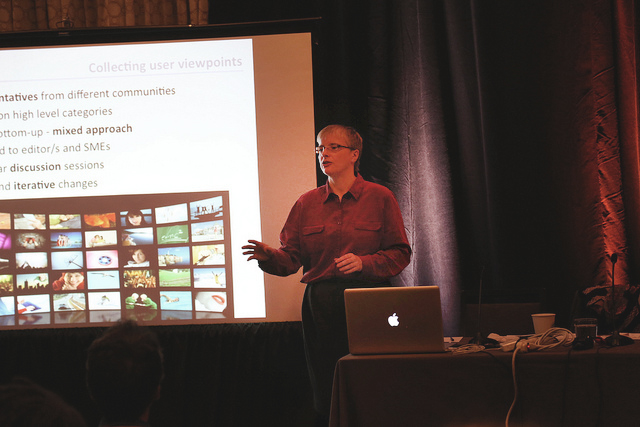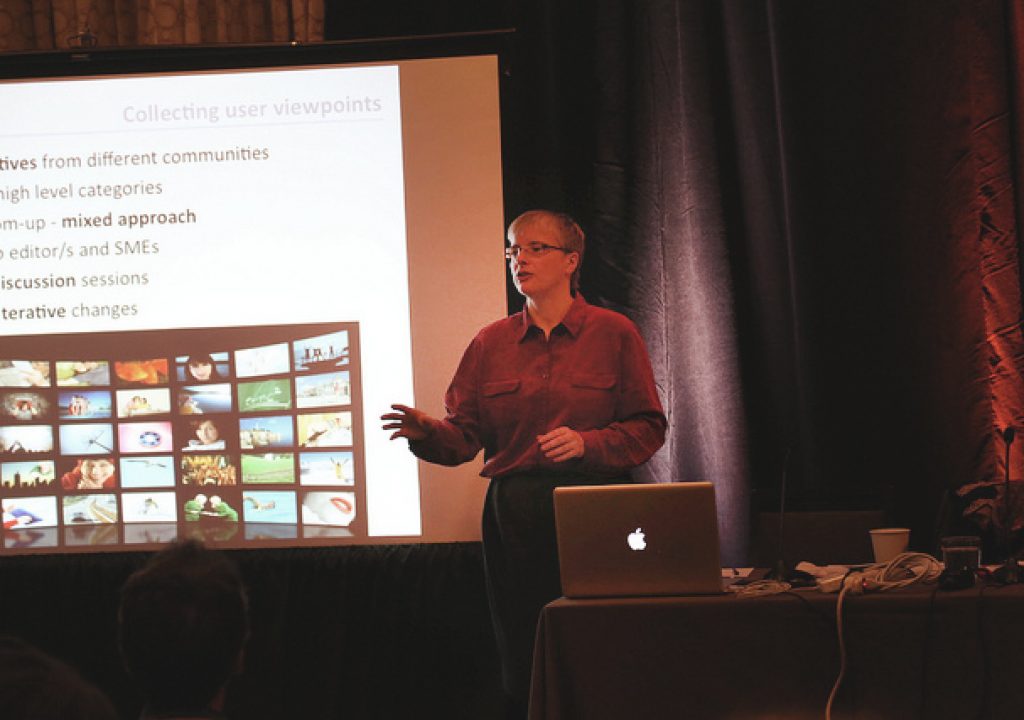 The Createasphere team did a great job putting on a lively and informative DAM conference in New York earlier this month. I gave a seminar about choosing the right words, labels, and categories for navigation and indexing and highlighted some of the common problems that crop up when you work with language and semantics. I was also honoured and highly delighted to be asked to be a DAMMY award judge for the second time.
The Createasphere team did a great job putting on a lively and informative DAM conference in New York earlier this month. I gave a seminar about choosing the right words, labels, and categories for navigation and indexing and highlighted some of the common problems that crop up when you work with language and semantics. I was also honoured and highly delighted to be asked to be a DAMMY award judge for the second time.
Keynote on being modular and flexible
Zach Brand of NPR delivered an inspiring and entertaining keynote on how to avoid the perils inherent in trying to create grand monolithic DAM systems and explained how by clever use of APIs and a flexible and modular approach, sophisticated and integrated DAM systems can be built that directly serve the needs of the business.
By talking us through various experiences – good and bad – at NPR, Zach showed how creative collaboration between content and technical teams can lead to great results in terms of efficiencies and cost savings and increased opportunities to promote and re-use content. A modular approach means that you can create systems that are flexible enough to cope with fresh demands, new initiatives, and even technological advances. Accepting that a system may never be completely “finished” on the one hand, offers the the ability rapidly to adapt and evolve on the other.
Be good to your metadata, and it will be good to you
A number of speakers and panellists highlighted the importance of good metadata for the success of any DAM system or project. When DAM projects fail, it is usually due to bad metadata.
Wesley Simpson of Turner explained that a good media asset taxonomy will solve all sorts of problems with your DAM.
Irina Guseva of The Real Story Group warned of the dangers of false economy by skimping on metadata capture and quality control. She pointed out that interns may appear to be cheap, but if they lack the knowledge and experience to deal with your metadata needs, you will end up paying far more in the long run, not just in having to re-work metadata but also in lost opportunity costs of assets being unfindable or unusable due to missing information. Some key metadata is too difficult for interns, for example extremely technical metadata to do with formats or technical standards, so good staffing is key.
It can be hard to get people enthused about metadata work, but I particularly liked the quotation ”metadata is a love note to the future” as a way of reminding those of us who work not just behind the cameras, but behind the camera operators, that we will be appreciated by those who follow in our footsteps. We could even claim to be the ones who are ensuring the content business has a future, because without metadata assets are lost.
Collaboration is key
Another theme was the importance of good co-operation and effective communication across different areas of the business, especially between IT and creative end users. With DAM systems now sitting as the hub at the heart of businesses, a successful DAM system implementation depends on different business communities coming together and taking joint ownership.
Holly Boerner of Grey Group pointed out that IT teams often go off by themselves and come up with clever ideas, but if those ideas don’t meet the needs of end users, they simply won’t be effective. So, getting the two communities to listen to each other is vital.
A good working relationship with software vendors is also crucial and it can be better to find a vendor that is a good cultural fit and understands the nature of your business than one that appears to meet all your requirements but does not grasp how your business operates. A good tip from Cynthia Parrish of Harris was to find out as much as you can about projects with other clients, so that you can learn and benefit from those experiences. For example, if you need to integrate your DAM with other systems, find out what your vendors are already integrated with, so you can avoid paying them to essentially do the same piece of work a second time.
Clouds, standards, and efficiencies
Cloud-based and software-as-a-service systems are becoming more common, with companies picking and choosing how to use them. For example, Turner use Cloud-based services for transcoding, ingest, search, and browse, but not for the more risk-averse and business critical aspects of master asset storage and management.
Dianne Kennedy of IDEAlliance explained PRISM (disambiguation – it is nothing to do with the NSA!) and its standardized schema and vocabularies for media management.
There was also an announcement of an extension to XMP by Adobe and Ad-Id for embedding advertising identification data in advertising assets to standardize tracking of advertising content, which has different behaviours to other forms of media asset.
There were calls for customers to engage with software vendors to ensure standards are supported – “if your vendor won’t adhere to key standards, change your vendor! Vendors do listen.” It was also noted that vendors typically respond to customers on standards much more than they listen to the standards committees.
Other topics were the use of DAM systems to improve workflow and increase efficiency – for example Sizzlepig offer an automated cropping and re-sizing solution that can save a lot of employee time fiddling about in Photoshop.
Joseph Busch of Taxonomy Strategies pointed out that “every re-use decreases the asset creation cost and increases the asset value”.
Media mixer
There were too many great sessions to cover in detail, but this is one that chimed with a lot of issues I have been thinking about lately. The Media Mixer project aims to facilitate fragmentation and re-purposing of media using semantic technologies. They use Linked Data principles to specify, index and describe content, and I was interested by the rights management aspects. A robust infrastructure for managing rights and payments that can work seamlessly and with minimal disruption to a user’s experience are key for building a viable online media industry business model.
DAM joy
Overall, I met lots of fascinating people working on a huge range of projects, from Hollywood movies to small specialist archives, but a common theme and motivation for why we all work in the industry is surely the DAM joy when someone finds assets they didn’t know existed, are then inspired and make new discoveries that lead them to create exciting new products and so generate new revenue streams.

Filmtools
Filmmakers go-to destination for pre-production, production & post production equipment!
Shop Now













